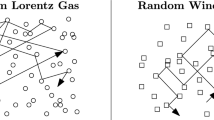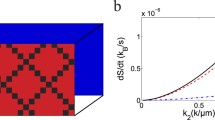Abstract
Although I had not previously been aware of Jean Ginibre’s work on random matrices, beginning in 1978 I became an admirer of his many papers on nonlinear waves in collaboration with Giorgio Velo. Their papers were amazingly profound and inspirational. I subsequently met Jean and Giorgio many times. I especially remember the pleasant time Jean and I spent together at a meeting in 2001 at Hokkaido University dedicated to the memory of the great Tosio Kato. The present announcement is a very brief summary of some of my recent mathematical work, joint with Yilun Wu, concerning a simple model of galaxies.
Similar content being viewed by others
A typical galaxy consists of a huge number of stars attracted to each other by gravity. For instance, the Milky Way has about 1011 stars. Mathematical studies of rotating stars and galaxies go back as far as Maclaurin in 1740. Rotation induces a change of shape. A kinetic model is especially appropriate for modeling galaxies. This means that the rotating collection of particles is treated continuously, with the position, time, and velocity as independent variables. In our model the particles have a fixed total mass and are attracted to each other by gravity but subject to no other forces. The system begins as spherical and static but then is allowed to rotate about a fixed axis. The rotation is expected to make it flatter at the poles and wider at the equator. Thus we are led to the Vlasov (or collisionless Boltzmann) equation
where v denotes the velocity and x the position of a particle. \(f=f(t,x,v)\ge 0\) is the density of particles in phase space and U is the gravitational potential with spatial density \(\rho (t,x)\):
Nonspherical solutions of this system (1), (2) have not been much studied in the mathematical literature. See [5] for a nice survey of the initial-value problem. The first mathematical treatment of steady states of axisymmetric solutions that we are aware of was by Rein [4], who constructed a local curve of nearly spherical solutions by means of the implicit function theorem. Such a local curve was also constructed by Andréasson et al. [1] within the context of general relativity. In Sects. 6–8 of [7] we constructed such a local curve with the additional property that the mass remains constant (independent of the rotation speed). In a different vein, Rein and Guo [6] constructed stable steady states by minimization of an energy-Casimir functional for a certain class of microscopic densities. The stability of spherical states was also studied by Guo and Lin [3].
Our purpose here is to announce the construction of a “global” connected set of steady states that have compact support and constant mass and that emanate from a spherical solution but deviate far from it. The constant mass condition means that there is no loss or gain of particles as the galaxy changes its rotation speed within the global set.
Here we only consider solutions that are independent of time t and are rotating around the \(x_{3}\) axis. Jeans’ theorem [2] states that every steady state depends only on the invariants of the flow. Two of these invariants are the energy E and the \(x_{3}\) component L of the angular momentum. Thus we can consider solutions that are axisymmetric and have the form
where κ is a measure of the intensity of rotation and the constant α is included for convenience. The microscopic density function ϕ is nonnegative. Then f is itself an invariant of the flow, and so it is automatically a solution of the Vlasov equation (1). By assuming this form of f, the unknowns reduce to the spatial density ρ, the constant α, and the constant intensity of rotation κ.
([8])
Given \(M_{0}>0\) and a broad class of functions ϕ, there exists a family \(\mathcal {K}\) of solutions \((\rho ,\alpha , \kappa )\) of (1), (2), (3) that are axisymmetric with total mass \(M_{0}\) such that
-
\(\mathcal {K}\) is a connected set in \(C_{c}^{1}(\mathbb{R}) \times \mathbb{R}\times \mathbb{R}\),
-
\(\mathcal {K}\) contains the nonrotating solution, and
-
in \(\mathcal {K}\) either the support of ρ or the rotation speed κ is unbounded.
An example of such a function ϕ is \(\phi (E,L)= |E_{-}|^{\nu }L^{2}\), where \(E_{-} = \min (E,0)\) and \(\nu \in (-\frac{1}{2}, \frac{3}{2}) \cup (\frac{3}{2},\frac{7}{2})\).
Conclusion:
It is proven that there exist global connected sets of solutions to this model of rotating stars.
Availability of data and materials
Not applicable.
References
Andréasson, H., Kunze, M., Rein, G.: Rotating, stationary, axially symmetric spacetimes with collisionless matter. Commun. Math. Phys. 329, 787–808 (2014)
Binney, J., Tremaine, S.: Galactic Dynamics. Princeton University Press, Princeton (2011)
Guo, Y., Lin, Z.: Unstable and stable galaxy models. Commun. Math. Phys. 279, 789–813 (2008)
Rein, G.: Stationary and static stellar dynamic models with axial symmetry. Nonlinear Anal. 41, 313–344 (2000)
Rein, G.: Collisionless kinetic equations from astrophysics - the Vlasov-Poisson system. In: Handbook of Differential Equations: Evolutionary Equations, vol. 3, pp. 383–476 (2007)
Rein, G., Guo, Y.: Stable models of elliptical galaxies. Mon. Not. R. Astron. Soc. 344, 1296–1306 (2003)
Strauss, W., Wu, Y.: Steady states of rotating stars and galaxies. SIAM J. Math. Anal. 49, 4865–4914 (2017)
Strauss, W., Wu, Y.: Global continuation of a Vlasov model of rotating galaxies. Kinet. Relat. Models 16, 605–623 (2023)
Acknowledgements
Not applicable.
Funding
Not applicable.
Author information
Authors and Affiliations
Contributions
The author read and approved the final manuscript.
Corresponding author
Ethics declarations
Competing interests
The author declares no competing interests.
Additional information
Dedicated to the memory of Jean Ginibre
Rights and permissions
Open Access This article is licensed under a Creative Commons Attribution 4.0 International License, which permits use, sharing, adaptation, distribution and reproduction in any medium or format, as long as you give appropriate credit to the original author(s) and the source, provide a link to the Creative Commons licence, and indicate if changes were made. The images or other third party material in this article are included in the article’s Creative Commons licence, unless indicated otherwise in a credit line to the material. If material is not included in the article’s Creative Commons licence and your intended use is not permitted by statutory regulation or exceeds the permitted use, you will need to obtain permission directly from the copyright holder. To view a copy of this licence, visit http://creativecommons.org/licenses/by/4.0/.
About this article
Cite this article
Strauss, W.A. A kinetic model of rotating galaxies. Adv Cont Discr Mod 2023, 16 (2023). https://doi.org/10.1186/s13662-023-03758-4
Received:
Accepted:
Published:
DOI: https://doi.org/10.1186/s13662-023-03758-4




